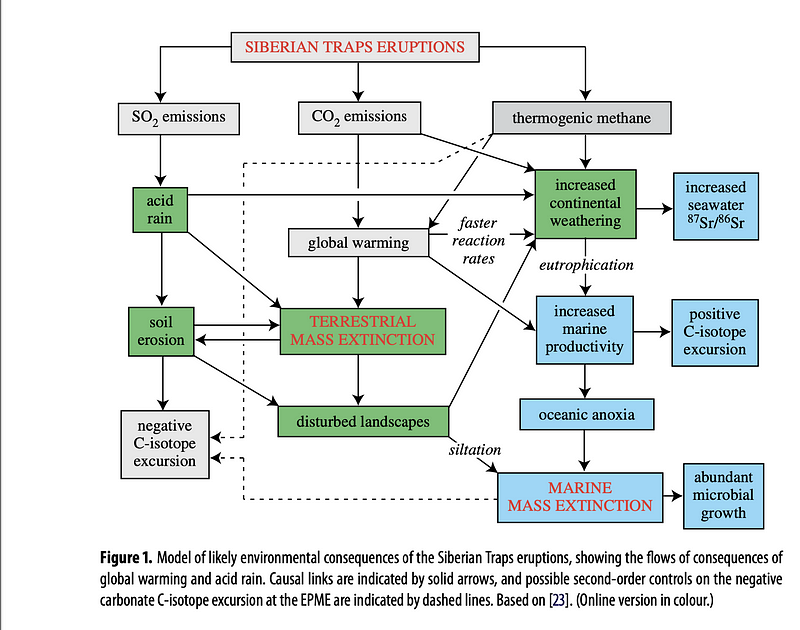The Reality of Mass Extinctions: Past Lessons for Our Future
Written on
Introduction
Five represents the number of fingers on your hand, the senses you possess, and the significant mass extinction events that have occurred throughout Earth's history. In this piece, I had the honor of speaking with Professor Mike Benton from the University of Bristol, an expert in Vertebrate Palaeontology. His research focuses on the evolution of notable species like dinosaurs and the ways in which environmental shifts, particularly mass extinctions, have shaped the biodiversity of birds, reptiles, and mammals. He has authored over 50 books and 400 scholarly papers, which are well worth a read.

To uncover the main questions posed in the interview, listen to the episode above!
The "Big Five," as they are commonly referred to, represent five crucial moments in our planet's history that everyone should be aware of (even if we aren’t). These are:
- Ordovician-Silurian (400 million years ago)
- Devonian (365 million years ago)
- Permian-Triassic (250 million years ago)
- Triassic-Jurassic (210 million years ago)
- Cretaceous-Tertiary (65 million years ago)
You might wonder, "Why should I care about events that happened so long ago?" Well, it's essential to reflect on the lessons learned from our predecessors as we navigate our own struggles for survival and consider how to mitigate the impending Sixth Mass Extinction.
Storytime
To grasp the history of mass extinctions, it's crucial to examine the most devastating one: the Permian-Triassic Extinction (PTME), which occurred 250 million years ago. During this catastrophe, approximately 96% of marine species and 75% of terrestrial species vanished.
A primary factor in the PTME was the eruption of Large Igneous Provinces (LIPs) in regions like Russia and China, which released vast amounts of CO2 and SO2—some of the most powerful greenhouse gases known to humanity. Thus, it was these greenhouse gases that contributed to the mass die-off of life on Earth during that period.

These historical threats now pose new concerns for us today.
According to Bill Gates, we emit 50 billion tons of CO2 into the atmosphere each year. While it's not from volcanic eruptions, the accelerated rate of carbon dioxide release is alarming. To illustrate the gravity of this situation, let me introduce you to Professor Mike Benton.
Questions We Need to Answer
In my conversation with Professor Benton, we tackled several pressing questions that often go overlooked. Let's explore them:
What current threats are we facing that were previously underestimated?
Threats like rising sea levels, increasing temperatures, and ocean acidification are commonly associated with climate change. However, when compared to previous mass extinctions, our situation appears dire. Professor Benton notes that while past extinctions occurred without human interference, our current demands for resources and overpopulation heighten the risk of a Sixth Mass Extinction.
What effect did ocean anoxia have on early land-dwelling vertebrates and invertebrates at the end of the Devonian?
The Devonian period, often called the "age of fish," marks the transition of aquatic species to land-dwelling forms. Ocean anoxia was a significant threat during this time, leading to the extinction of many species. While fish like Dunkleosteus faced immediate consequences, some early land plants managed to adapt and thrive despite the challenges.
Could this foreshadow future impacts of anoxia, where marine life suffers more severely than terrestrial species, ultimately affecting us?
How much more do we have to learn about mass extinctions?
Professor Benton asserts that with today's technological advancements, we can understand mass extinctions better than ever. While ethical concerns prevent experimental tests on populations, refining our understanding of the various factors involved can shed light on these historical events.
What are the chances of a Large Igneous Province erupting soon?
Large Igneous Provinces, formed when magma pushes through the Earth's crust, were a significant cause of the PTME. Fortunately, these eruptions are not periodic, and while we can't predict when they will occur, it is unlikely that one will happen in our lifetimes. However, if it does, the consequences could be far worse due to our deteriorating ecosystems.
Can we adapt quickly enough to the rapid changes caused by industrial activity?
Other species take between 0.5 to 1 million years to recover from hyperthermal events. Humans have limited adaptability to harsh conditions, unlike organisms such as tardigrades. Professor Benton suggests that it is improbable we would recover from a hyperthermal event, emphasizing the need to stabilize global temperatures instead.
Is there an aspect of combating mass extinctions that requires more attention?
Despite our increasing awareness of climate change, Professor Benton believes that resource exploitation is often overlooked. He stresses that the foundational structures of our societies need immediate reform, as our daily actions contribute to extinction, from driving cars to using plastic.
Perhaps we need to reconsider the ways of our ancestors and hunter-gatherer societies, as suggested by Dr. Christopher Ryan in "Civilized to Death," to fully grasp the extent of the ongoing destruction.
What role does technology play in finding solutions?
While technology can aid in addressing environmental issues, it is not a panacea. Figures like Bill Gates are working to integrate technology into our lives, but meaningful change must originate from individual intent.
No amount of technology can shift the paradigm if there's no genuine commitment to change.
The Maths Doesn’t Lie
One intriguing aspect of mass extinctions is their causes. While there are five major events, in the past 600 million years, there have been 12 significant extinction events. This totals 17 events, with four attributed to asteroids. Remarkably, 13 of these events were caused by climate change, highlighting the human influence on extinction.
When the Sixth Mass Extinction occurs, it will likely be a result of our actions rather than an external force like an asteroid.
Conclusion
From my discussion with Professor Benton, it is clear that significant work remains to be done. The insights gained from historical mass extinctions, particularly the PTME, can guide our efforts to prevent a similar fate today. We must consider altering societal dynamics to benefit the planet and focus on less recognized threats.
It is essential to learn from Earth's history to avoid allowing 9 out of 10 species to disappear again.
Remember, 13 out of 17 extinction events were induced by Earth itself—let that inform your choices as we strive to protect our species from extinction.
If you want to watch the full interview, please click here to view it on my YouTube channel, the 'EarthSci Show,' where I plan to host more interviews and podcasts in the future!
Bibliography
Hyperthermal-driven mass extinctions: killing models during the Permian–Triassic mass extinction — Professor Mike Benton — https://cpb-eu-w2.wpmucdn.com/blogs.bristol.ac.uk/dist/5/537/files/2021/01/2018hyperthermals.pdf — accessed 24/2/21
Mass Extinctions and the future of life on Earth — Prof. Mike Benton — https://www.ted.com/talks/michael_benton_mass_extinctions_and_the_future_of_life_on_earth — date accessed 28/3/21
The role of extinction in evolution — David Raup — https://www.pnas.org/content/pnas/91/15/6758.full.pdf — date accessed 30/2/21
Large Igneous Provinces — https://en.wikipedia.org/wiki/Large_igneous_province — date accessed 6/3/21
Bill Gates and Rashida Jones Ask Big Questions (Podcast) — https://www.gatesnotes.com/podcast — date accessed 19/1/21